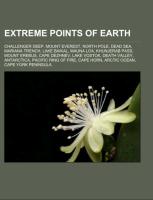- Start
- Extreme points of Earth
Extreme points of Earth
Angebote / Angebote:
Source: Wikipedia. Pages: 117. Chapters: Challenger Deep, Mount Everest, North Pole, Dead Sea, Mariana Trench, Lake Baikal, Mauna Loa, Khunjerab Pass, Mount Erebus, Cape Dezhnev, Lake Vostok, Death Valley, Antarctica, Pacific Ring of Fire, Cape Horn, Arctic Ocean, Cape York Peninsula, South Pole, Alert, Nunavut, Mount Elbrus, Chimborazo, Eureka, Nunavut, Extremes on Earth, Gavdos, Southernmost settlements, Dome A, HMRG Deep, The southernmost city in the world, North Cape, Norway, Extreme points of Europe, Extreme points of the Antarctic, Cabo da Roca, Dallol, Ethiopia, Lake Assal, Extreme points of the Commonwealth of Nations, Murchison Promontory, Extreme points of Antarctica, Ridge A, Cape Chelyuskin, Extreme points of the Arctic, Mount Thor, Lowest temperature recorded on Earth, Cape Nordkinn, Hope Bay, Al 'Aziziyah District, Extreme points of North America, Extreme points of South America, Commonwealth Bay, Extreme points of Eurasia, Kaffeklubben Island, Arctic Cape, Punta Mariato, Cape Columbia, Antarctic Specially Protected Areas, Lukunsky grove, Ary-Mas, Five southernmost capes, Cape Byron, Calypso Deep, Cape Froward, Cape Prince of Wales, Antarctic Specially Managed Areas, Knivskjellodden, Steep Point, Extreme points of Afro-Eurasia, Ponta do Seixas, Cape Fligely, Tanjung Piai, Monte Caburaí, Hellenic Trench, Punta de Tarifa, South Point, Punta Pariñas, Cape Baba, Extreme points of Central America, Serra do Divisor National Park, Cape St. Charles, Litke Deep, Extreme points of the Northern Mariana Islands. Excerpt: Antarctica Adelie Penguin chicks in Antarctica, with MS Explorer and an iceberg in the backgroundAntarctica (pronounced or ) is Earth's southernmost continent, encapsulating the South Pole. It is situated in the Antarctic region of the Southern Hemisphere, almost entirely south of the Antarctic Circle, and is surrounded by the Southern Ocean. At 14.0 million km (5.4 million sq mi), it is the fifth-largest continent in area after Asia, Africa, North America, and South America. For comparison: Antarctica is nearly twice the size of Australia. About 98% of Antarctica is covered by ice that averages at least 1.6 kilometres (1.0 mi) in thickness. Antarctica, on average, is the coldest, driest, and windiest continent, and has the highest average elevation of all the continents. Antarctica is considered a desert, with annual precipitation of only 200 mm (8 inches) along the coast and far less inland. The temperature in Antarctica has reached -89 °C (-129 °F). There are no permanent human residents, but anywhere from 1, 000 to 5, 000 people reside throughout the year at the research stations scattered across the continent. Only cold-adapted organisms survive there, including many types of algae, animals (for example mites, nematodes, penguins, seals and tardigrades), bacteria, fungi, plants, and protista. Vegetation where it occurs is tundra. Although myths and speculation about a Terra Australis ("Southern Land") date back to antiquity, the first confirmed sighting of the continent is commonly accepted to have occurred in 1820 by the Russian expedition of Fabian Gottlieb von Bellingshausen and Mikhail Lazarev. The continent, however, remained largely neglected for the rest of the 19th century because of its hostile environment, lack of resources, and isolation. The Antarctic Treaty was signed in 1959 by 12 countries, to date, 47 countries have signed the treaty. The treaty prohibits military activities and mineral mining, proh...
Folgt in ca. 5 Arbeitstagen
